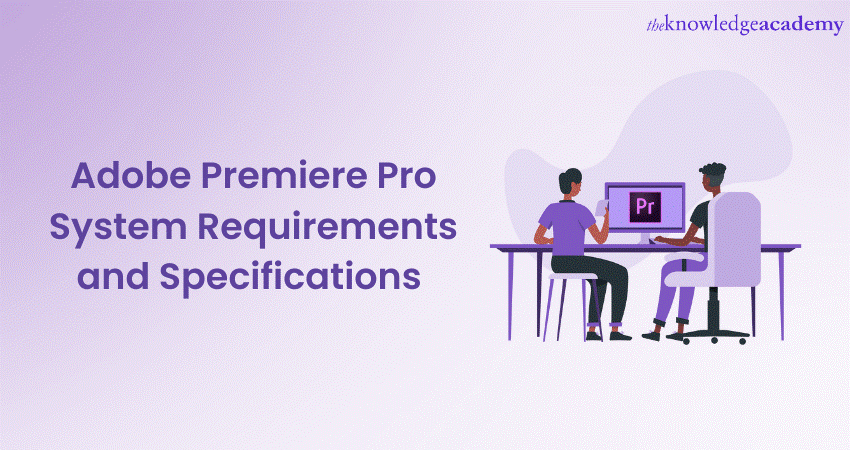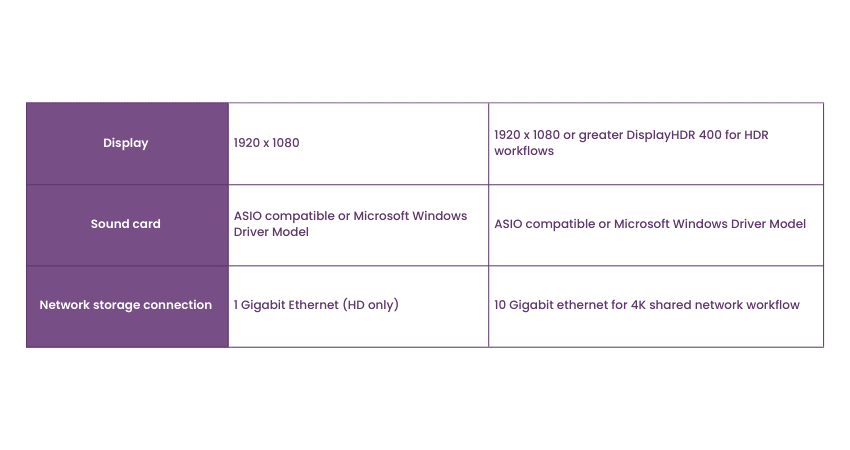We may not have the course you’re looking for. If you enquire or give us a call on +44 1344 203 999 and speak to our training experts, we may still be able to help with your training requirements.
Training Outcomes Within Your Budget!
We ensure quality, budget-alignment, and timely delivery by our expert instructors.

Adobe Premiere Pro, esteemed by many as a cornerstone in Video Editing, demands precise hardware configurations for optimal performance. Today, Video Editors, Filmmakers and Animators use this tool for all of their editing requirements. But without understanding the Adobe Premiere Pro System Requirements, it can be challenging to use this tool efficiently.
According to Statista, Adobe Inc. made over 13.31 billion GBP in the year 2022. You see how widely this tool is utilised for developing videos and images! If you are new to the field of Video Editing, it’s time to get familiar with its system requirements. In this blog, we will take you through the Latest Adobe Premiere Pro System Requirements, ensuring that your editing journey remains smooth and uninterrupted.
Table of Contents
1) What is Adobe Premiere Pro?
2) Understanding the System Requirements for Adobe Premiere Pro
3) Recommended system specifications
4) Optimising the performance of Premiere Pro
5) Conclusion
What is Adobe Premiere Pro?
Adobe Premiere Pro is a frequently used Video Editing software application, part of the Adobe Creative Cloud suite. It was Launched in 2003; it has become an industry standard for Video Editing due to its timeline-based nature, catering to both novices and professionals. The software boasts advanced features such as multi-camera editing, 3D editing, and seamless integration with other Adobe products like After Effects and Adobe Audition.
The rising demand for high-quality video content means that tools like Premiere Pro are in the limelight. With its comprehensive suite of editing tools, users can craft polished visual narratives from raw footage, whether for films, television, or online content. However, to fully harness this software’s capabilities, a robust computing system is essential. Adobe's advanced software necessitates specific system requirements to function optimally, ensuring precision and efficiency throughout the editing process.
Understanding the System Requirements for Adobe Premiere Pro
As an industry-leading Video Editing software, Premiere Pro demands specific criteria to function effectively on any device. While Adobe provides both minimum and recommended system requirements, it's pivotal to understand that the minimum Adobe Premiere Pro Requirements are set to merely run the software. So, let’s have a detailed look at these requirements:
For Windows users
Windows offers a versatile platform for Adobe Premiere Pro, balancing powerful performance with user-friendly functionality. Requirements for Premiere Pro in Windows are as follows:
a) Processor: An Intel® 6thGen or a newer CPU is required. Alternatively, an equivalent AMD processor will suffice.
b) Operating System: This editing software is compatible with Windows 10 (64-bit), but one should ensure they have version 1803 or a more recent version installed.
c) RAM: The minimum RAM required is 8 GB. However, for better responsiveness, especially while handling bigger projects, 16 GB is recommended.
d) Graphics card: Adobe Premiere Pro requires at least 2 GB of GPU VRAM. For users unsure about their graphics card's compatibility, Adobe provides a comprehensive list of recommended graphic cards on its official website.
e) Hard disk space: One must ensure they have 8 GB of free space on their hard disk for the installation process. Additionally, more free space is required during installation, but note that the software won't install on removable flash storage.
f) Sound card: Sound cards that support ASIO protocol or the Microsoft Windows Driver Model are compatible.
g) Internet: An active internet connection is mandatory to activate the software, validate subscriptions, and for accessing online services that Adobe offers.
For macOS users
The macOS provides a seamless environment for Adobe Premiere Pro, integrating intuitive design with robust Video Editing capabilities. Some of the requirements for Premiere Pro in macOS are as follows:
a) Processor: An Intel® 6thGen or a newer CPU is essential.
b) Operating System: Adobe Premiere Pro is compatible with macOS v10.14 or subsequent versions.
c) RAM: 6 GB of RAM is suggested for a smooth, flawless experience; however, 8 GB is considered the bare minimum.
d) Graphics card: The software requires 2 GB of GPU VRAM.
e) Hard disk space: 8 GB of available hard-disk space is necessary for installation. During the installation process, additional free space will be needed. It's worth noting that the software won't install on volumes using a case-sensitive file system or on removable flash storage devices.
f) Internet: A reliable internet connection is vital for software activation, subscription validation, and to utilise Adobe's online services.
Wish to edit beautiful videos? Try our Adobe Premiere Pro Masterclass!
Recommended system specifications
In the realm of Video Editing, professionals demand more than just basic functionality. They require swift responsiveness, quick render times, and an environment that supports intensive tasks without hiccups. To achieve this, meeting Adobe's recommended system specifications is crucial:

a) Processor: Adobe suggests an Intel® 7thGen or newer CPU. Alternatively, an AMD equivalent would work just as efficiently. These modern processors are designed to handle multiple tasks concurrently, ensuring that Video Editing, playback, and rendering are smooth and lag-free.
b) RAM: For editing HD media, 16 GB of RAM is the recommended amount, providing adequate space for the software to temporarily store and retrieve data. However, when working with 4K media or even higher resolutions, 32 GB or more becomes essential. This additional memory ensures that even with larger file sizes and more complex tasks, your system remains responsive and efficient.
c) Graphics card: Video Editing software often offloads some of its processing tasks to the GPU (Graphics Processing Unit). Adobe recommends graphics cards with 4 GB of GPU VRAM. This not only supports real-time playback but also aids in quicker rendering and exporting times, which is especially beneficial when working with graphics-intensive sequences or applying multiple effects.
d) Hard disk: Adobe suggests using a fast internal SSD (Solid State Drive) for installing the application and caching. SSDs are considerably faster than traditional HDDs, resulting in faster boot times, quicker application launches, and improved overall responsiveness. Additionally, it's advisable to have an additional high-speed drive for storing media files, ensuring smooth playback and efficient access to your project assets.
e) Monitor resolution: A minimum of 1920 x 1080 display resolution is recommended by Adobe. This resolution offers a clear and broad view of your timeline, media files, and effects, making it easier to fine-tune details and achieve precise edits.
Learn all about editing videos with layers with our Adobe After Effects Masterclass!
Optimising Premiere Pro performance
Users can carry out many measures to achieve peak performance in their Adobe Premiere Pro software, despite their system having the bare minimum requirements. Here are the various practices users can follow to maintain optimal software performance:
Adjusting playback resolution: One of the easiest methods to achieve optimal performance in the Premiere Pro software is to experiment with the playback resolution to evaluate what suits best. This measure is regardless of the system’s specifications. Users can do so by selecting ‘Playback Resolution’ under the Playhead.
Disable high-quality playback: Premiere Pro allows its users to boost their timeline performance by right-clicking on the playhead and disabling the feature of high-quality playback.
GPU hardware acceleration: Users can leverage their content creation with accelerated GPU hardware functionality in Premiere Pro, especially if their systems are built to support it. This means that the system’s supported video card will work better for the sake of better performance. Users can activate GPU hardware acceleration by navigating to the Media option under the Premiere Pro.
Update RAM settings: Premiere Pro allows users to boost their system performance by updating the settings of their RAM storage. They can navigate to the Memory option under the Premiere Pro main tab. They will then be given the option to decide the amount of RAM adjustment necessary to dedicate to their Premiere Pro software.
Cache settings: Cache is an aspect of any software that users might possibly overlook most of the time. Cache is basically memory that is stored on the hard drive and can prove a hinderance to the system performance if it’s too high. Hence, users are recommended to store their cache on a Solid State Drive (SSD) instead of the HDD for peak performance. They can navigate to the Media Cache under the Premiere Pro tab.
CPU for Premiere Pro
Users can avail numerous CPU options on the market and face indecision while narrowing down to their selection. MAC users are provided Apple’s proprietary chipset such as the budget-friendly M1 CPU or the high-end M1 ultra chip designed for any form of encoding. Moreover, Windows users are provided the options of either Intel or Ryzen chips which makes their decision making process a lot trickier. On one hand they have the Ryzen 3600 and Intel i5 core chipset that is designed to accomplish the bare minimum, and the mid range chips include the Intel core i7 and Ryzen 7 chips. These options are best suited to operating with higher-end codecs, layers, effects and resolutions. Finally the high-end range includes the Intel core i9 and Ryzen 9 chips for professional users.
GPU for Premiere Pro
Users are recommended the use of graphic cards offered by Nvidia. While AMD manufacturers graphic cards like the Radeon series, these are never considered the industry-standard. Although Premiere Pro is optimised for the NVIDIA Quadro cards, basic or amateur users are best suited to use the Nvidia GeForce RTX series.
More importantly, users need to be cognizant of the fact that majority of GPUs cost a fortune, like the RTX 3090. They still can avail pocket-friendly graphic cards like the GTX 1660. Moreover, the RTX 3070 and 3080 are excellent options from the midrange and are benchmark Nvidia GeForce GTX GPUs. They possess excellent GPU VRAM which is intended to speed up rendering on Premiere Pro.
Learn to use gorgeous gradients with our Adobe Illustrator Masterclass!
Conclusion
Understanding the Adobe Premiere Pro System Requirements is crucial while diving into the world of Video Editing. Depending on your project's nature, these requirements can vary significantly. Investing wisely not only boosts workflow but also future-proofs your system, ensuring long-term efficiency. Aligning with Adobe's recommendations guarantees a streamlined editing journey.
Interested in printing your own material? Try our Adobe InDesign Masterclass!
Frequently Asked Questions
Upcoming Office Applications Resources Batches & Dates
Date
 Photoshop Course
Photoshop Course









 Top Rated Course
Top Rated Course



 If you wish to make any changes to your course, please
If you wish to make any changes to your course, please


